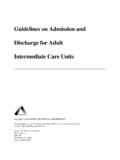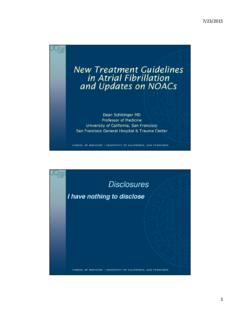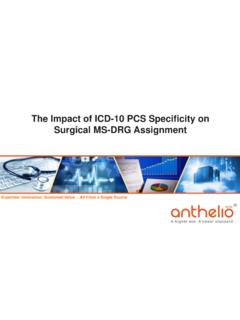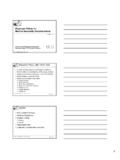Transcription of Limits and monitoring - who.int
1 587 Limits and monitoring For each control measure it is important to first define the operational Limits (range) which, as part of the overall process train, leads to the supply of water that meets the intended use (including the health targets). However, because it is rarely practical to measure the concentration of hazards directly, some other means of control measure performance needs to be identified and becomes the target of monitoring . Therefore, a relationship between control measure performance, as determined by measurable parameters, and hazard control performance needs to be established.
2 This relationship can be established using theoretical and/or empirical studies (see Validation in Chapter 11). In general long-term performance data, design specifications and objective scientific and empirical analysis are likely to be combined. An operational limit (often defined as alert limit or action limit) is a criterion that indicates whether the control measure is functioning as designed. Exceeding the operational limit implies that action is required to prevent the control measure moving out of compliance.
3 The term critical limit is often in some water safety plans to single out operational Limits linked directly to absolute acceptability in terms of water safety. monitoring is the act of conducting a planned series of observations or measurements of operational and/or critical Limits to assess whether the components of the water supply are operating properly. 59 Not all measurable properties of control measures are suitable for this type of monitoring . Only where the following criteria are satisfied it is possible to define operational Limits for control measures: Limits for operational acceptability can be defined; these Limits can be monitored, either directly or indirectly ( , through surrogates); a pre-determined corrective action (response) can be enacted when deviations are detected by monitoring (see Chapter 8).
4 The corrective action will protect water safety by bringing the control measure back into specification, by enhancing the barrier or by implementing additional control measures; and the process of detection of the deviation and completion of the corrective action can be completed in a timeframe adequate to maintain water safety. monitoring PARAMETERS The parameters selected for operational monitoring should reflect the effectiveness of each control measure, provide a timely indication of performance, be readily measured and provide opportunity for an appropriate response.
5 Some water quality characteristics can serve as surrogates (or indicators) for characteristics for which testing is more difficult or expensive. Conductivity, for example, is a widely used surrogate for total dissolved solids. Examples of operational parameters during treatment processes and water distribution are outlined in Table 60 Table : Examples of water treatment and distribution operational parameters Treatment step/process Operational parameter Raw water Coagulation Sedimentation Filtration Disinfection Distribution system pH 9 9 9 9 Turbidity (or particle count) 9 9 9 9 9 9 Dissolved oxygen 9 Stream/river flow 9 Rainfall 9 Colour 9 Conductivity (total dissolved solids)
6 9 Organic carbon 9 9 Algae, algal toxins and metabolites 9 9 Chemical dosage 9 9 Flow rate 9 9 9 9 Net charge 9 Streaming current value 9 Headloss 9 CT 9 Disinfectant residual 9 9 Disinfection by-products
7 9 9 Hydraulic pressure 9 CT = Concentration x time OPERATIONAL Limits The water safety plan team should define the operational (or critical) Limits for each control measure, based on operational parameters such as chlorine residuals, pH and turbidity, or observable factors, such as the integrity of vermin-proof screens and as shown in Table The Limits need to be directly or indirectly measurable.
8 Current knowledge and expertise, including industry standards and technical data, as well as locally derived historical data, can be used as a guide when determining the Limits . Target or operational Limits might be set for the system to run at optimal performance while the term critical Limits might be applied when corrective actions are required to prevent or limit the impact of potential hazards on the safety and quality of the water. Limits can be upper Limits , lower Limits , a range or an envelope of performance measures.
9 They are usually indicators for which results can be readily interpreted at the time of monitoring and where action can be taken in response to a deviation in time to prevent unsafe water being supplied. monitoring monitoring relies on establishing the what , how , when and who principles. In most cases, routine monitoring will be based on simple surrogate observations or tests, such as turbidity or structural integrity, rather than complex microbial or chemical tests. The complex tests are generally applied as part of validation and verification activities (see Chapter 11) rather than in monitoring operational or critical Limits .
10 Table shows what could be monitored if bacterial contamination of source water is identified as a potential hazard and feral or pest animal control and disinfection are identified as control measures. It can be seen from these examples that the frequency of monitoring will depend upon what is being monitored and the likely speed of change. Table : monitoring examples Animal control Disinfection control What?















